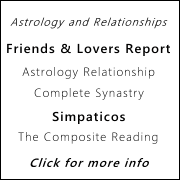
Home
| Astrology
Index | Numerology
Index |
A Primer on the Art of SynastryAstrological Relationship AnalysisSynastry is the process of comparing the horoscope of two individuals to make an educated guess about how well they will get along in a romantic relationship. This is something of an advanced process, so it is necessary to know a little about basic astrological principles.The zodiac is made up of 12 signs. Each of these signs represents 30 degrees of the full astrological circle. Every individual has all the ten planets in his or her horoscope; the Sun, the Moon, Mercury, Venus, Mars, Jupiter, Saturn, Uranus, Neptune and Pluto. So it has to follow that these bodies are situated in the birth chart in one or another of the twelve signs as well as one of the twelve houses. Which sign and which house depends on the exact moment of birth and where the birth occurred. You may call yourself an Aries or a Taurus, but that only makes reference to which sign the Sun was in when you were born. The Moon and other planets were probably in other signs and houses scattered around the circle. The twelve signs, twelve houses and ten planets are the basic components of the horoscope. In synastry, we compare the relative positions of the planets and the houses between your chart and the chart of another. It's that simple; and that complicated. Aspects between the HoroscopesThe first thing usually considered is the aspects. In considering aspects, we look at one horoscope, and measure the number of degrees from that person's planets to the planets in the prospective partner's horoscope. By calculating this we can make basic predictions about where the strengths and weaknesses of the relationship are. We can evaluation the staying power of the relationship, and guess about what ways the people involved are going to get along and not get along. We can also surmise which of the partners will take the lead in various situations, and finally what problems will be faced in the relationship.In my work I like to keep it fairly simple looking at only the strongest of the aspects. These include the conjunction, sextile, square, trine and opposition. When two planets are in conjunction, they are "within orb" or about 5 or 6 degrees of being in the same degree of the same sign. When sextile, the planets are within orb of 60 degrees; when square, 90 degrees; trine, 120 degrees; and opposition, 180 degrees. For the most part, sextiles and trines are considered easy aspects. Squares and oppositions are usually more difficult and suggests tension. Conjunctions can be either and it usually depends on which planets are involved. In almost every synastry comparison, you will find at least some areas of ease and some areas of stress. Sometimes it will be difficult to draw a definite conclusion about whether or not the relationship will work. There will be areas of life where things do quite nicely, and there will be other areas which are much more challenging. When looking at your synastry result for the first time, it is important to remain objective. Do not become alarmed at the first negative issue encountered. Likewise, avoid reading through the report wearing "rose-colored glasses" seeing only the positive and ignoring the stressful. The Ascendants and Horoscope HousesThe next area of consideration is house placement. Observe where the planets of one person's chart fall in the houses of the other horoscope. The horoscope will reveal the Ascendant on the first house cusp, and the other 11 signs on the cusps of the next 11 houses. The most important of these is the Ascendant or the Rising sign. How the Ascendant signs pair up in a relationship is very important because it suggest how the personalities will blend together.Some charts will have what are called intercepted houses. If you have an interception, there will be two signs, exactly opposite one another, that will not be on the cusp of any house. In this case, the signs either directly before or directly after the intercepted signs will rule two houses each. Such interceptions are common and have no particular bearing on relationships. Starting from the Ascendant, generally the cusps will be ruled by the next (unless you do have an interception) sign of the zodiac on house cusp 2 though 12. If you are a Sun sign Taurus but your Ascendant or 1st House cusp is in Aries, the Sun in your chart will fall in the 2nd house. Because the second house is about money and possessions, your life force (Sun) will be focused largely on what you value in a material sense. In a synastry comparison, most important considerations are aspects to, and comparative house positions of the Sun, Moon, Venus, Mars, Saturn, as well as the Ascendant and Descendant (first and seventh house cusps). Mars and Venus show attractions including sexual attractions. The Sun and the Moon show ego and emotional satisfaction, respectively. Saturn usually defines staying power or restrictions that block long term happiness. Mercury and Jupiter are less important, but play supporting roles and can add or detract from the quality of the relationship depending on the aspects. The outer planets, Uranus through Pluto, are just not important when considering a relationship. The outer planets are more important when in close conjunction with, the Sun, the Moon, Mars or Venus. When considering the synastry between two individual charts, one needs to understand as much as possible about the individuals involved. With this understanding, the context of the synastry will become more focused. If one of the individuals is seeking a reclusive, quiet, and reserved situation, and the other craves excitement, change, and adventure, the fact that there are many trines and sextiles in the combined chart won't help satisfy the basic needs of the individuals. Conversely, you may see mostly hard angles and difficult house placements and conclude it is not a good relationship only to learn that it has indeed been a strong love affair for years. Examining the individual charts should help determine if the basic needs are being filled. I realize that these brief notes for the novice astrologer will probably generate more questions than answers on this topic. At least it is a start. The relationship Package OfferQuestions about your relationship? Astrology and Numerology can supply answers! Michael specializes in relationship analysis using the astrological composite chart and synastry (chart comparison) methods, as well as comprehensive comparisons of the core numerology profiles. Helpful, thorough, and caring, his relationship understanding techniques are always very personal and enlightening. Visit here for more information. |
     
|